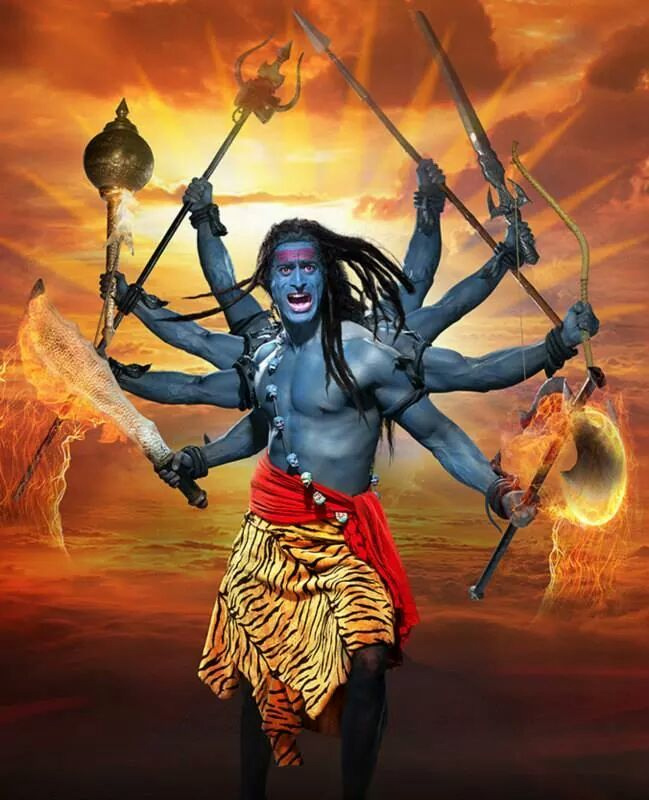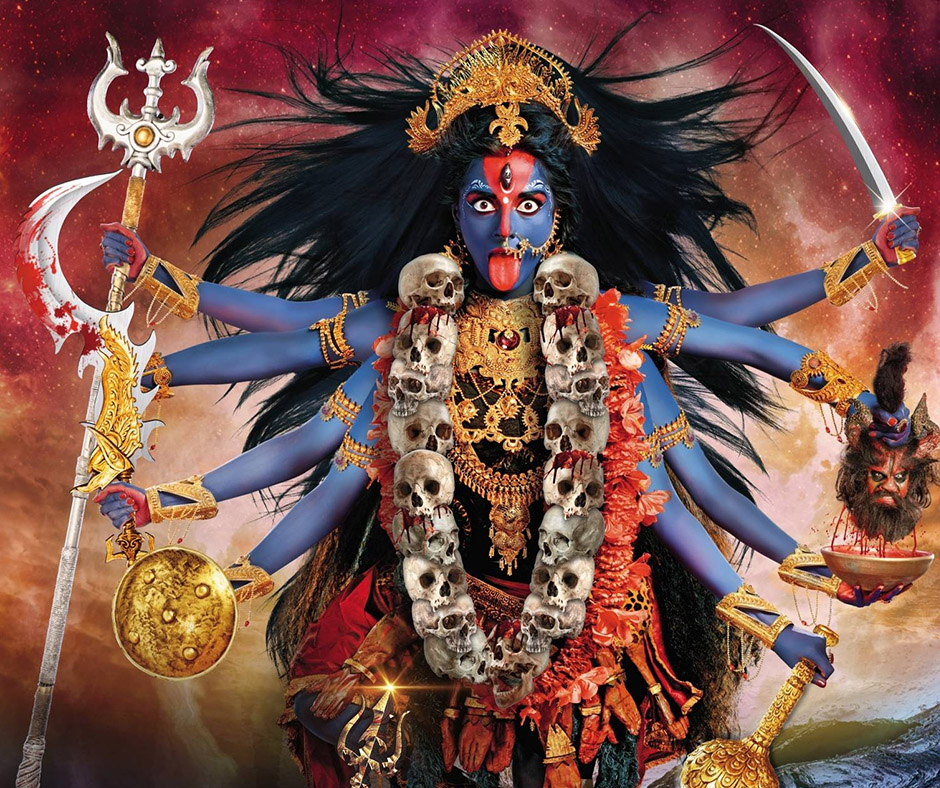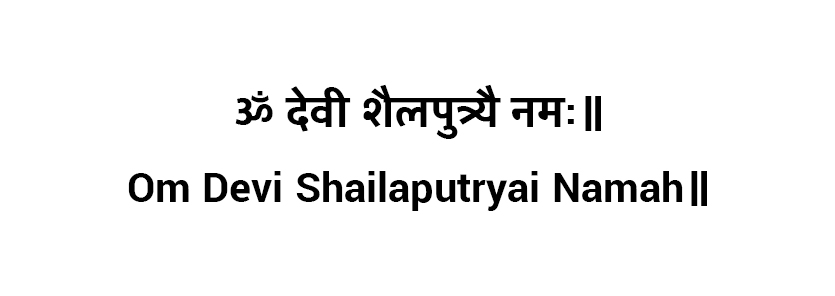Navaratri also spelled as Navratri, (Sanskrit– “Nine nights”) is one of the major auspicious festivals in India celebrated in the honor of feminine form of Mother Divine, also known as Nav Durga (Sanskrit –“Shakti”). The Devi Shakti manifests itself in many forms. Divine Shakti represents and reflects qualities of strength, compassion, beauty, power, anger and transformation. In Hinduism, Navratri is celebrated over nine nights ends on the tenth day – Dussehra also called as “Vijayadashmi”. Sharada Navratri occurs during the month of Ashwin (September-October).
The Nine Forms of Nav Durgas
On these nine days of Navaratri, nine forms of Goddess Durga are worshipped. The nine avatars of “Maa or Mata” (Mother Divine) are known as Mata Shailputri, Mata Brahmacharini, Mata Chandraghanta, Mata Khushmanda, Maa Skanda Mata, Maa Katyayani Mata, Mata Kaalratri, Maa Maha Gauri, and Maa Siddhidatri Mata.
Today, on day one of Navaratri, I will share the significance and story of Mata Shailputri.
In Navratri, recitation of Maa Shailputri Mantra gives peace of mind and keeps away all the evil from your life and makes you healthy, wealthy and prosperous.
Maa Shailputri Vrat Katha
On Day 1 of Navaratri, Maa Shailputri is worshipped as the first form of Goddess Durga. Goddess Shailputri is born to Parvat Raj Himavan (Lord of Himalayas) and Devi Menavati. In Sanskrit, “Shail” means mountain and “Putri” means girl, hence Goddess is known as the Daughter of Mountains. Maa Shailputri is also known as Devi Parvati, Sati Bhavani, Hemavati (Ruler of Himalayas).
Before the birth of Devi Shailputri, Divine Mother incarnated as Goddess Sati in House of Prajapati Daksha. She was the youngest daughter of King Daksha and Queen Prasuti. Prajapati meaning Kings of the Kings, had all priestly skills and was in power for the creation of worlds. Prajapati Daksh was an epitome of Ego, as he considered himself prestigious over all other creations. Daksha was an ardent follower of Lord Vishnu and considered himself responsible for all the happenings of the world and more powerful than Lord Shiva. Daksha Prajapati, also a Manasputra (mind created son of Lord Brahma), refused to accept Shiva as “Supreme God” as Lord Shiva lived the life of a hermit, smeared bhasma (ash) on His body and was garlanded with serpents. Lord Shiva was different than other Gods and Prajapati Daksha could not revere and accept Him as Lord Shiva lived an ascetic life and His followers were daityas and yakshas. Prajapati Daksha, was in complete ignorance about the reality of Lord Shiva as “Supreme God”.
Devi Sati wanted to marry Lord Shiva, but Prajapati Daksha did not approve their marriage. Despite Prajapati Daksha’s strong disapproval, Devi Sati chooses Lord Shiva as her consort in her swayamvara (ceremony where bride can choose her own husband). Daksha’s hatred of the ascetic Bhagvan Shiva grew even stronger because Lord Shiva was now his son-in-law. Daksha was angered and felt humiliated by marriage of Devi Sati and Lord Shiva. In great resentment, Daksha broke all ties with Devi Sati. The thought of Lord Shiva’s marriage with his beloved daughter haunted Prajapati Daksha for several days. In order to humiliate Lord Shiva and vent out his anger, Prajapati Daksha organizes “Maha Yagna” (Great Offering).
King Daksha invited all the Gods and Goddesses, Demigods, and all the sages of the Earth and Heaven to this Yagna, but did not invite Lord Shiva and Devi Sati. Sage Dadhichi, an ardent follower of Lord Shiva, upon noticing Lord Shiva’s absence, remarked, “Oh Daksha, why have you not invited Lord Shiva?. He is crucial to any sacrifice. You must invite Devi Sati and Lord Shiva”.
Daksha arrogantly ignoring Sage Dadhichi’s request said, “I have invited Lord Vishnu, the “Preserver of the Universe”. I have invited Lord Brahma, the “Creator of the Universe”. I have called all of you. Who else is there to call? Shiva is an uncivilized hermit and is unworthy, He does not deserve to be invited in this Yagna”.
In the Himalayas, Devi Sati, despite being uninvited, wanted to attend the Yagna and asked Lord Shiva if She could attend the ceremony. Lord Shiva reluctantly tried to stop Devi Sati, but on the behest of Goddess Sati granted her permission for attending the Yagna.
https://www.high-endrolex.com/26Goddess Sati along with Nandi (dearest mount of Lord Shiva) and all other Rudraganas (followers of Lord Shiva) came to the Yagna organized by King Daksha. Daksha purposefully ignored his Daughter Sati’s entry along with all Rudraganas at the “Yagna” place. Daksha considered Devi Sati as his disobedient daughter for marrying Lord Shiva against his wish and forgets that Devi Sati is the incarnation of “Adi Shakti”.

During the Yagna, Devi Sati is confronted about Lord Shiva’s absence, Daksha in front of all guests openly ridicules Lord Shiva as an uncouth, uncivilized, poor hermit deserving no respect. Devi Sati, could not endure such insults of Lord Shiva, and in rage of anger, took the enormous divine form of Adi Shakti. In this illuminous powerful form, Devi Sati speaks to Daksha, “Daksha Prajapati, how can you talk such disrespectfully about Shiva? Why did you forget about Shiva? What kind of sacrifice is performed without His presence? How can this Yagna start without Him? Adi Shakti commendably describes the greatness of Lord Shiva to all the guests in Yagna, she is furious upon Daksha’s ignorance and ill-mannered behaviour. Goddess confronts Daksha for his foolishness in not recognizing the divine nature of “Shiv-Shakti”. Adi Shakti then creates a divine yogic fire and self immolates Herself in Her own energy. Devastated and grief-stricken Nandi informed Lord Shiva about the tragedy of Devi Sati’s self immolation and of the ill-fated happenings at the Yagna.
When Lord Shiva came to know about what happened, he plucked a lock from His matted hair and thrashed it on the ground. Rudra avatar “Veerbhadra”- an extremely fierce form of Lord Shiva was born. Shiva orders Veerbhadra to destroy Daksha’s Yagna and slain Daksha. Veerbhadra moves in a violent rage killing anyone coming in His path. He slains Daksha’s army like a flash of lightening, and heads towards Daksha’s Yagna place. Looking at Veerbhadra’s wrath, Prajapati Daksha bowed down on his knees and prayed Lord Vishnu, “O Hari, you are my protector. You gave me the boon to ask you for help when I needed the most. You are the sole Supreme Being of this Yagna, the giver of fruits for this Yagna. Oh Lakshmi Narayana, help me. Save my life from Veerbhadra’s wrath”.
Upon hearing Daksha’s pleas, Lord Vishnu stalled Veerbhadra in the battlefield. Veerbhadra was unstoppable, He looked up at Lord Vishnu and asked in unbending voice, “O Hari, why are you helping Daksha, in this Yagna?” How can you take the side of Daksha’s misconduct?
Lord Vishnu replied, “I am subservient to my devotees, like you are to Shiva. Daksha is my devotee, and he requested Me to be the ultimate protector for this Yagna. I am bind by My words as you are by your Shiva’s orders”.
Veerbhadra said, “How can I fight you, You are as dear as Shiva is to Me.”
Lord Vishnu replied, “Veerbhadra, obey Mahadev’s orders and fight with Me. If you defeat Me, I will go to my abode”.
On this, Lord Vishnu blew Panchjanya conch shell to commence the battle. A fearsome battle began between the two Supreme forces – Rudra and Sri Hari. The battle ground trembled, there was rain of astras, shastras and asteroids from the skies, the use of celestial weapons filled the three worlds with earthquakes, tsunamis, hurricanes, floods, storms and wild fires. The long-drawn battle between Sri Hari and Veerbhadra seemed never-ending. Discovering that it was impossible to defeat Veerbhadra by celestial weapons, Lord Vishnu, then at once used His invincible Sudarshan Chakra against Veerbhadra. Lord Vishnu twirled Sudarsharn Chakra around His right index finger and He let loose mighty Sudarchan Chakra towards Veerbhadra. In reply, Veerbhadra tried to stop the impact of Sudarshan Chakra by creating a protective shell around Himself.
To unbind and unleash Veerbhadra from His own shell, Lord Shiva created “Bhadrakali” – the fierce form of Goddess Shakti from his matted hairlocks and directed Bhadrakali to help Veerbhadra come out of this binding situation. Bhadrakali came to the battlefield to untie Virbhadra from His own spell.


Accepting His defeat Lord Vishnu returned to Vaikunth, and Lord Brahma left for Brahmaloka.
Veerbhadra stormed into the Yagna place, severed Daksha’s head and threw it into the Agni-kund (Fire pit). After Shiva’s ganas left, the devas and sages went to Lord Brahma to ask for help. When they told him about the death of Daksha, Lord Brahma was really distressed. He didn’t know what to do. Brahma, the sages, and the devas then went to Lord Vishnu and asked Him for a solution. Sri Vishnu told them to fall at the feet of Lord Shiva and apologize. Thus, Vishnu, Brahma, the devas, and the sages went to Mount Kailash. They praised Lord Shiva and prayed Him to fix everything. A sobered and ever merciful Lord Shiva conceded to the prayers and revitalized Daksha Prajapati with life by placing the Yagna’s Goat head on to Daksha’s severed head. The ever-grateful Daksha begged Mahadev for his pardon and prayed to Him with great sincerity and devotion everafter. He then performed a Yagna again with Lord Shiva on the High Seat and with all the Devas to receive their blessing.


With intense grief, Lord Shiva took Devi Sati’s body in His arms. He took the lifeless body of Sati from Yagna and started roaming around the universe carrying her in His arms by neglecting his roles and responsibilities. To end Lord Shiva’s extreme pain, Lord Vishnu used His Sudarshana Chakra to cut the body of Devi Sati to pieces, which fell on Earth. The total pieces were 52, and they fell on 52 different places, and all these places are known as holy 52 Shakti Peeths.
Devi Sati took rebirth as Shailputri, the daughter of King of mountains in the Himalayan valley.
Appearance of Maa Shailputri
Maa Shailputri is an embodiment of Shakti. She has a serene face and pleasant aura. She rides a bull (Nandi), has crescent Moon on her forehead and is holding a Trident in her right hand and lotus in her left hand.
Goddess of Mooladhara Chakra

Maa Shailputri symbolizes the Mooladhara Chakra or root chakra – the ultimate gateway to spiritual awakening. The first day of Navaratri symbolizes the beginning of the spiritual journey of an ardent devotee. Devi Shailputri being Mooladhara shakti teaches lessons to her devotees by awakening his or her consciousness by energizing the Mooladhara Chakra. Many sages and gurus observe fast during this day to channelize their Mooladhar chakra and move gradually upwards in spiritual realm. The spiritual journey starts all the way from Mooladhar Chakra towards Crown Chakra.
Worshipping Maa Shailputri
Maa Shailputri is worshipped on the first day of Navratri. The significance of first day of Navaratri begins with the ritual of “Ghatasthapana”. It is believed that the Moon, the provider of all fortunes, is governed by Goddess Shailputri and any bad effects of the Moon can be overcome by worshipping this form of Adi Shakti. Worshipping Goddess Shailputri, offers peace, harmony and overall happiness to all devotees, prayers offered to Maa Shailputri keeps diseases and negativity away and brings stability and success in career and business.
Maa Shailputri Mantra

Maa Shailputri Prathana (Prayer)

Maa Shailputri Stuti (Praise To God)

Maa Shailputri – Dhyana

Maa Shailputri Aarti

I hope you enjoyed Maa Shailputri Vrat Katha, as much as I enjoyed writing it. If you liked the blog, please do drop a comment. I wish you all Happy, Healthy and Peaceful Navratri. Stay Blessed.


